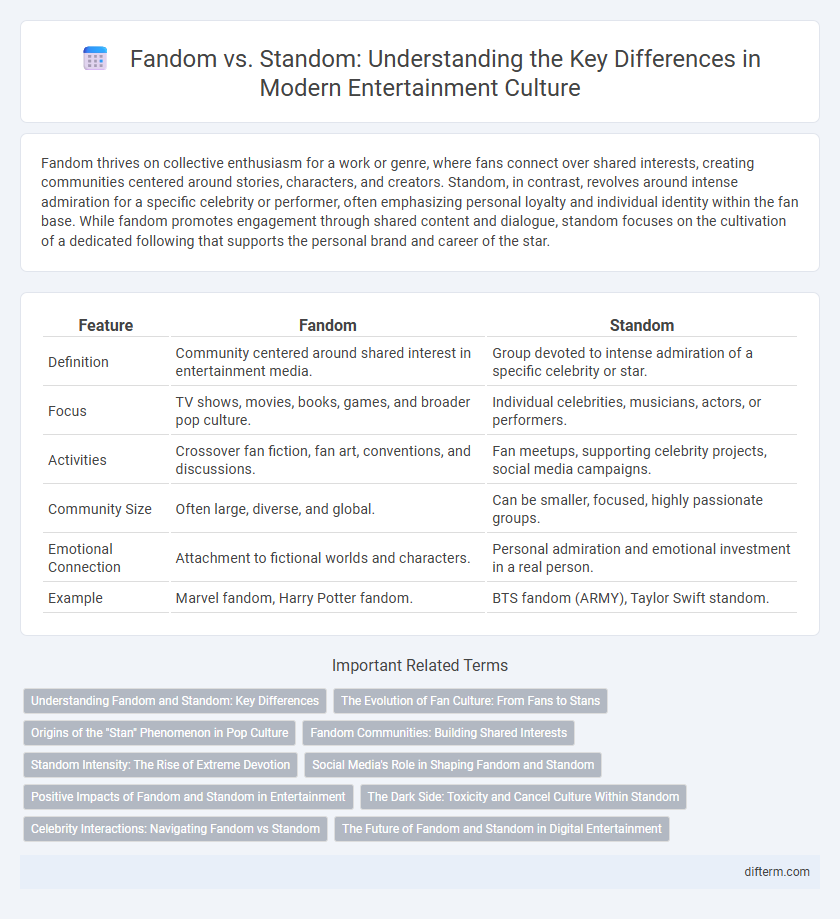Fandom thrives on collective enthusiasm for a work or genre, where fans connect over shared interests, creating communities centered around stories, characters, and creators. Standom, in contrast, revolves around intense admiration for a specific celebrity or performer, often emphasizing personal loyalty and individual identity within the fan base. While fandom promotes engagement through shared content and dialogue, standom focuses on the cultivation of a dedicated following that supports the personal brand and career of the star.
Table of Comparison
| Feature | Fandom | Standom |
|---|---|---|
| Definition | Community centered around shared interest in entertainment media. | Group devoted to intense admiration of a specific celebrity or star. |
| Focus | TV shows, movies, books, games, and broader pop culture. | Individual celebrities, musicians, actors, or performers. |
| Activities | Crossover fan fiction, fan art, conventions, and discussions. | Fan meetups, supporting celebrity projects, social media campaigns. |
| Community Size | Often large, diverse, and global. | Can be smaller, focused, highly passionate groups. |
| Emotional Connection | Attachment to fictional worlds and characters. | Personal admiration and emotional investment in a real person. |
| Example | Marvel fandom, Harry Potter fandom. | BTS fandom (ARMY), Taylor Swift standom. |
Understanding Fandom and Standom: Key Differences
Fandom centers around a shared enthusiasm for media, celebrities, or franchises, fostering community engagement through discussions, fan art, and events. Standom, often linked to fan bases of music idols or pop stars, emphasizes personal devotion and support, including fan meetings and strongly emotional connections. Understanding these nuances clarifies how fandoms prioritize collective experience while standoms focus on individual idol-centric admiration.
The Evolution of Fan Culture: From Fans to Stans
Fan culture has evolved significantly from casual admiration to intense devotion, creating distinct communities known as fandoms and stans. Fandoms represent collective groups of enthusiasts who engage in shared interests through discussions and events, while stans signify hyper-engaged fans exhibiting unwavering support and active promotion of their idols. The rise of social media platforms has accelerated this transformation, fostering real-time interaction, fan-driven content creation, and global connectivity that deepen emotional investment and influence entertainment industries.
Origins of the "Stan" Phenomenon in Pop Culture
The "stan" phenomenon originated from Eminem's 2000 song "Stan," depicting an obsessive fan whose intense devotion shaped the term's meaning in pop culture. Unlike traditional fandom, stans actively engage on social media, amplifying their idol's presence through viral content and fervent defense. This evolution reflects a shift from passive admiration to proactive, often aggressive, participation in entertainment communities.
Fandom Communities: Building Shared Interests
Fandom communities thrive by creating immersive spaces where members share deep enthusiasm for specific media, fostering meaningful connections and collective creativity. These groups engage through forums, fan art, fanfiction, and conventions, enhancing their sense of belonging and cultural identity. Unlike standoms, which focus more on individual celebrities, fandom communities prioritize shared interests in stories, characters, and worlds, driving sustained interaction and collaborative projects.
Standom Intensity: The Rise of Extreme Devotion
Standom intensity represents a surge in extreme devotion where fans exhibit unwavering loyalty through immersive engagement and personal identity integration. Unlike general fandom, standom involves passionate advocacy, exclusive content consumption, and active participation in fan communities, amplifying emotional investment. This heightened commitment drives significant cultural and economic impact, reshaping entertainment industry marketing and content creation strategies.
Social Media's Role in Shaping Fandom and Standom
Social media platforms amplify fandom and standom by enabling instant interaction, content sharing, and community building around celebrities and franchises. Algorithms curate personalized feeds that reinforce fan engagement, driving trends and expanding the reach of both fan and stan cultures. Online spaces facilitate collective identity formation and mobilization, transforming passive admiration into active cultural participation.
Positive Impacts of Fandom and Standom in Entertainment
Fandom and standom both foster deep community engagement, enhancing shared experiences around entertainment franchises and celebrities. These collective passions drive increased content creation, such as fan art and discussions, boosting the visibility and cultural relevance of entertainment properties. The enthusiasm within fandom and standom also contributes to economic growth by supporting media sales, live events, and merchandise, reinforcing the entertainment industry's vitality.
The Dark Side: Toxicity and Cancel Culture Within Standom
Standom, characterized by obsessive and often aggressive fan behavior, frequently cultivates toxic environments marked by harassment and relentless criticism, contrasting with the generally more positive engagement seen in fandoms. Toxicity within standoms manifests through cancel culture, where public shaming and boycotting campaigns target individuals for perceived offenses, often without due process or room for redemption. This aggressive gatekeeping stifles creative expression and alienates both artists and fans, undermining the community's overall vibrancy and inclusivity.
Celebrity Interactions: Navigating Fandom vs Standom
Celebrity interactions often reflect the contrasting dynamics between fandom and standom, where fandom represents enthusiastic admiration and standom embodies a more personal, sometimes intense, connection to celebrities. Fandoms tend to engage through organized fan clubs, social media communities, and collective creativity like fan fiction or fan art, fostering a shared cultural experience. In contrast, standom emphasizes direct artist-to-fan engagement, including intimate meet-and-greet events, exclusive content access, and personalized communication, shaping deeper relational bonds with celebrities.
The Future of Fandom and Standom in Digital Entertainment
Fandom and standom represent evolving forms of audience engagement in digital entertainment, with fandom emphasizing collective community participation while standom centers on individual idol worship. The future of these phenomena lies in integrating immersive technologies like virtual and augmented reality, enhancing interactive experiences and personalized content delivery. Data analytics and social media platforms will further shape fandom and standom dynamics, enabling creators to tailor experiences and build deeper emotional connections with their audiences.
Fandom vs Standom Infographic

 difterm.com
difterm.com